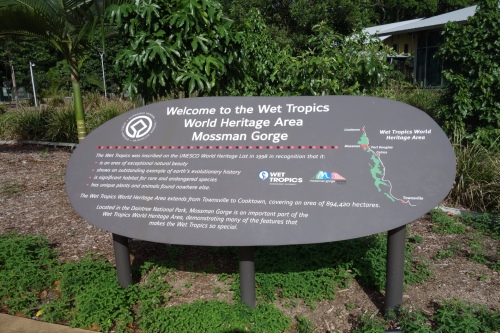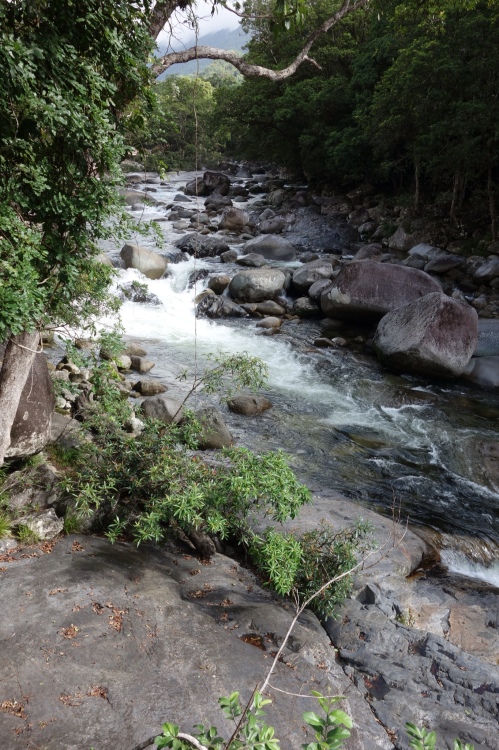Tags
It's time to leave my cabin and collect a new home. This time it's a campervan, and the thought of it daunts me. After all, my normal vehicle is a Yaris. Our first moments alone together aren't auspicious: I can't seem to engage first gear, which is a disadvantage in a city of traffic lights and roundabouts.
However, our relationship improves, and I head north to Mossman in the forests of the Daintree, a world heritage area. The road is windy, but there's not much traffic, and the speed limit hovers between 60 and 80. The road is beautiful: put my hand out the window one way and I touch deeply forested hills: put it out the other and it dangles in the Coral Sea. I have to recalibrate my thinking about distance here. Sixty kilometres takes a couple of hours, and that's not only because I dawdle and sightsee. My campsite is by the Mossman River. I manage to reverse and plug into electricity, but I don't manage to realise that the campervan table does double duty as bed base and for two nights I huddle on a very narrow mattress.
I'm off early the next morning to shop for supplies: I love being able to put them straight in the refrigerator. And then to the real business of this journey north. I make my way to Mossman Gorge, and set off on the path less travelled, away from the rest of the shuttle bus passengers. I can hear a river roaring and soon I'm beside it, looking down at boulders and rushing water through the trunks of trees. The boardwalk is actually made from recycled plastic, which provides a non-slip surface, requires less maintenance and doesn't rot.
The track, dirt now, soon moves to the rainforest, and rain falls in sheets. People pass wearing towels and raincoats, or more suitably clad merely in rain. I have an umbrella, but it's not much use. I love the rain. It draws unexpectedly rich colour from bark and fungi. When it stops, drops still fall, moving leaves and making me suspect the presence of scurrying animals, never quite seen. This rainforest is bigger in every way than the patches I'm used to on the south coast. The buttresses are immense and elegantly curved, collecting moss and leaves and ferns in their swirls.
Back at the information centre, I prowl around the shop looking for a gift for my daughter's Polish mother-in-law. I'm drawn to wallet with a design of a dilly bag, white threads on green, and as I'm buying it I meet the artist, Pamela Salt. She was named after her great grandmother, Wawu Jirray, which means spirit-plenty, good-hearted, a lot to give. Kuku Yulanji women have woven dilly bags from the black palm for thousands of years. She lets me take her photo, in front of the painting, and in front of the palm that provides the fibre for the weaving the painting represents. The fibre comes from the trunk, between the top ring and the black. This is a gift that fits: Ola is spirit plenty, good hearted and has a lot to give, and when she visited Australia palms were the thing that most caught her attention – palms at the airport and then burrawangs at Potato Point.

















Brave of you to drive a campervan, I’m not sure I’d fancy parking one! Or driving on the narrow lanes here in Cornwall. Does it usually rain so much in north Queensland in April? I always associate rain there in the summer months. My visit was in winter (July/August) and it was very dry. Lovely details as usual 🙂
LikeLike
April’s the end of the wet. Peak touro time begins in May. It was showers, rather than consistently wet. The van was surprisingly easy to manoeuvre: a very small turning circle for its size.
LikeLike
Beautiful description of the rainforest in the rain, there is a very special feel to the air after rain in the tropics. Every photo glows especially the fungi. I chuckled to imagine you huddled on those narrow benches before you discovered the drop down table. How did you manage to not roll out??? A campervan is by far the best way to travel, we went all through this area in Matilda. Which way are you going to Cooktown, by the highway or along the track? We went along the highway. Are you back home yet?
Will have to come back and catch up with your journey, I’ve missed a lot while we have been off line.
LikeLike
I put my suitcase on the floor with a pillow and an upside-down washing up bowl on top, and I had a bit of support. I felt a fool when I finally had my “Aha!” moment. I took the highway to Cooktown. The coast road is seriously 4WD – two very very steep hills. Were you blogging then? I’d like to see through your eyes.
LikeLike
The highway is a very interesting drive. We decided the coast road would be way to hard for Matilda, even though a local tried to tell us we could do it… here is a post about Cape Trib https://pommepal.wordpress.com/2011/08/23/1976/ this is Cooktown https://pommepal.wordpress.com/2011/08/07/1925/
LikeLike
Thanks for the links. I was planning to hunt them down, but you saved me the trouble. I’m surprised locals encouraged you to use the Bloomfield track: my son suggested they disliked tourists, but he’s a cynic.
LikeLike
I think it was maybe tongue in cheek and he didn’t realise what we were driving… No way would I put Matilda over that sort of road.
LikeLiked by 1 person
Fascinating Fungi and trees, the roots along the track make it look like the trees are taking a walk.
LikeLike
You’d have loved the walk I think. I was so lucky it rained: it removed the above-canopy glare. Photography in the rainforest has always been problematic. I like your image of the walking trees.
LikeLike
You are adventurous to drive a campervan. I loved the freshness of these rain-soaked scenes: the wet tree trunks, shining leaves and mossy roots, the brightly-coloured fungi and the swift river, so clear. I wonder whether it might be Roaring Meg, which used to be a mining site years ago. We may even have talked about it and had a laugh. Very rain-soaked here, with a storm equivalent to a category 2 cyclone and consequently lots of damage as well as flooding in the Hunter. I am OK apart from a few drips on the stairs and a lot of broken frangipani branches in the backyard. I still have power. Others not so lucky.
LikeLike
I love your description of my photos. It’s the Mossman River – Roaring Meg off my path a bit, although I did see some reference to it. Glad you didn’t suffer too much from the rain. The plane trip back was a bit bouncy.
LikeLike
The Mossman River is beautiful and you do that beauty full justice in your photos. In contrast, I will photograph for you the carnage in our local park. It is horrific, particularly the old established trees like Banksia integrifolia lying uprooted and split. Hilary let me use her green waste bin for the broken frangipani branches and I have just about cleaned up all the leaf litter for my regular bin. So not far away from normality for me. Not so for some of the small businesses I frequent in town, to whom I paid visits today to check on their wellbeing. Many are still closed. A house along our street has lost its roof and at least one other has a tarpaulin.
LikeLike
This a terrific piece of travelogue, and yes, as Suzanne says, the close up shots are SOOO vivid. Also, this not the kind of landscape I associate with Australia, so thank you for that insight.
LikeLike
This part of the world is wilderness and wet tropics, remoter than I expected.
LikeLiked by 1 person
How wonderful and how brave. Are you travelling far in the camper? I think of doing such a thing but for now are staying in the deep south. All your photos are terrific – as usual it is your close ups they really speak to me. I look forward to hearing more about your travels.
LikeLike
Going as far as Cooktown. I have seven days because I’m not on a barge back from Bamaga. I still regret Bamaga, but what a substitute!
LikeLiked by 1 person
I’m out of touch – a barge back from Bamaga – it sounds like the title of a poem. Enjoy your travels. They sound wonderful.
LikeLike
It could still happen. 2017, combined with Laura Dance Festival. My niece said she’d collect us from Laura – 800km round trip! The barge back.
LikeLike